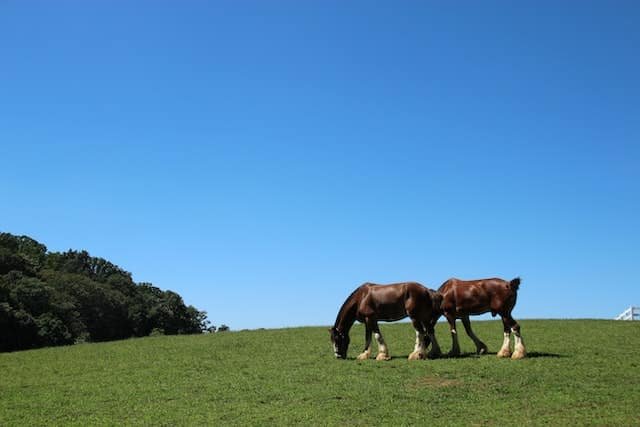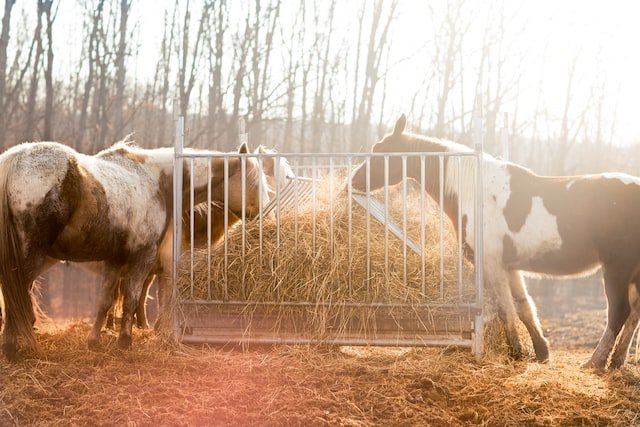Do horses eat grass? The answer, of course, is Yes. But the really interesting question is – how can horses eat just grass and still be so strong, fast and healthy? From where do they get essential nutrients? From where do they get protein for their enormous muscles?
To answer these questions we need to see how horses evolved. We need to understand how their anatomy changed to adapt to a changing environment where forests were replaced by grasslands. And we need to understand how their efficient digestive system is able to extract more value from grass than you or I ever could.
So, let’s dive in and understand how the horse became a highly efficient grass-eating animal.
60 million years ago …
The Eohippus lived about 60 million years ago and is the earliest known ancestor of the modern horse. It was a small, four-toed animal that weighed no more than 10 pounds, was no taller than a fox, and ate mostly fruits and leaves. The Eohippus was not made for exclusively eating grass and it didn’t need to be.
Over the next 20 or so million years, the Eohippus was replaced by newer versions of the horse like the Orohippus and the Mesohippus. Slowly, the modern horse was taking shape.
Evolution: From forest dweller to grassland grazer
About 30 million years ago the climate in North America began to change. Drier climates forced forests to make way for grasslands which we refer to today as the prairies.
Together with the climate and the environment, the horse too was undergoing changes. These changes, mostly anatomical changes, helped the horse to consume grass – which was found in abundance – and develop the ability to run and escape predators.

Horses started becoming taller and develop powerful legs. This not only meant that they could run fast and outrun predators it also meant that they could run for long and cover long distances looking for the best grass that they could find.
And so over the millennia horses adapted to their environment not only to survive but to thrive and grow in numbers.
An Anatomy Made For Eating Grass
Some of the specific anatomical changes that made it possible for horses to eat grass were made to their jaws, teeth and digestive systems.
The horse’s jaws became longer and its teeth changed from being leaf-shaped to becoming more flat and ideal for grinding grass. The modern horse has very sharp incisors to bite off the grass and large molars and pre-molars to grind the grass. The incisors are in front with 3 incisors on each side. Behind are the pre-molars and molars (in adults only), again 3 on each side.
The teeth and the powerful jaws are able to grind the grass into a paste. This makes it easier for the horse’s digestive system to extract as many nutrients out of the grass as possible.
These changes to the mouth, jaws and teeth are just one of the many ways the horse adapted over millions of years to become the Equus Caballus or the modern horse as we know it.
Digesting Cellulose & Extracting Protein From Grass
A very common question that many people have is how can horses be herbivores, eat only grass and hay, and still have such powerful muscles and be so strong? Where do horses get their protein from? Remarkably, horses can extract protein from grass.
And they can do so with evolutionary magic called Hindgut fermentation.
One of the main components of a plant’s cell walls is a complex carbohydrate called cellulose. Cellulose is what gives a plant its body and its structure. Cellulose is insoluble and indigestible in humans. If your parents were telling you to eat your vegetables because your body needed fiber, unknowingly they were asking you to eat more cellulose. Cellulose gives bulk to our stools and makes us more regular.
But because we humans cannot digest cellulose, it passes through our digestive tract virtually untouched. Horses on the other hand can break down cellulose and get benefits out of it. This is done through hindgut fermentation.
In hindgut fermentation, bacteria in the horse’s gut (specifically in its colon and cecum) break down cellulose and extract the protein out of the grass. So using hindgut fermentation, horses can digest cellulose from grass and vegetation – something we humans cannot do.
And this is why horses continue to eat hay or grass and, in most cases, have little need for any other kind of food.
In Conclusion
So do horses eat grass? You bet they do. And the reason is that evolution, over millions of years, has ensured that they can extract almost all necessary nutrients from grass. Their powerful jaws and sharp teeth can grind the grass into a paste. And their gut bacteria can extract protein from cellulose – something we humans cannot do.
This has all made it possible for the horse to survive and thrive on a diet of grass and hay. And that’s why, even today, horses continue to eat grass.



